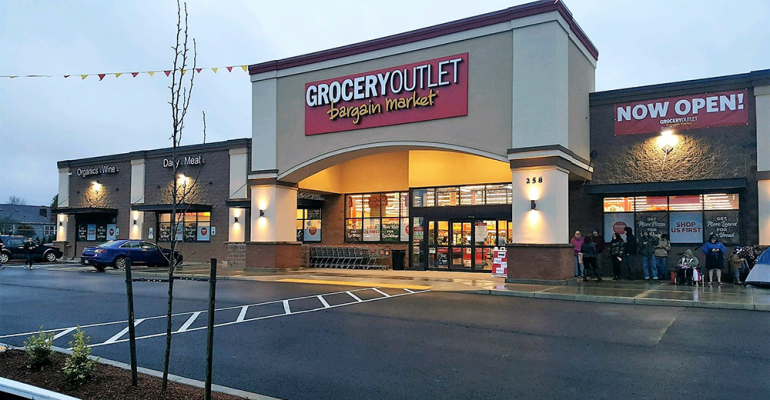Grocery Outlet stock took a steep dive on Tuesday following the release of the discount grocer’s Q1 earnings report where the company lowered its earnings forecast due to unexpected disruptions in implementation of new technology.
Stock in the company dropped in value from $25.98 per share prior to the release of the report to $20.16 by mid-morning on Wednesday, a decline of more than 22%.
The grocer also reduced its forecast for the remainder of the year, reducing its projection for adjusted earnings per share to a range of $0.89 to $0.95 from the previous outlook of $1.14 to $1.20 per share.
The Emeryville, Calif.-based grocer’s forecast also dropped in the following categories:
- Comparable store sales increase declined to a range of 3.5% to 4.5% from the previous outlook of 3.0% to 4.0%
- Gross margin declined to approximately 30.5% from 31.3%
- Adjusted EBITDA declined to a range of $252 million to $260 million from $275 million to $283 million
Net sales were up 7.4% to $1.04 billion for the quarter, while comparable store sales increased 3.9% due to a 7% increase in transactions that was offset by a 2.9% drop in average transaction size, the company said.
Despite the positive sales results, gross margin dropped 180 basis points to 29.3%, mainly the result of difficult technology upgrades that began in August of 2023. Those disruptions also caused a 210-basis-point decline in gross margins, according to the report.
“Despite progress with our systems transition and ending the operator commission support program, as planned, we are disappointed that additional systems conversion issues resulted in a higher than expected adverse profit impact,” Grocery Outlet President RJ Sheedy said in a press release. “Our long-term growth potential remains intact and we look forward to returning to more normalized business results as we near the end of our systems transition.”
In the earnings call, Sheedy acknowledged that the company was “very disappointed with our poor Q1 results,” adding that Grocery Outlet is “committed to getting these system impacts behind us very soon.”
The tech upgrades that disrupted Grocery Outlet’s business operations over the last eight months were related to both warehouse product expiry data and store-level reporting, Sheedy said.
“We have since resolved both of these and the negative impact to first quarter gross margin came in as expected at about 100 basis points. We’ve reduced warehouse shrink close to normal levels with better data visibility, and accurate store-level reporting enabled us to end the commission support program in March.”
On a brighter note, Sheedy said Grocery Outlet opened six stores in Q1, bringing total store count to 474 by the end of the quarter. The grocer has already opened six more in the second quarter. “We are positioned well for openings in the second half of the year,” he added.
The completion of the grocer’s purchase of United Grocery Outlet on April 1 added another 40 store locations across six new states, Sheedy said. That brings their total estimated new store count to a range of 58 to 62 by the end of 2024.
Grocery Outlet also completed the rollout of its personalization app to all locations during the first quarter.
“The app allows us to communicate our weekly deals to customers and customize their treasure hunt experience,” Sheedy said. “We are encouraged by the initial customer response with over 400,000 total downloads so far, and Q1 sales penetration of 6%.”
Grocery Outlet is still set to release its private-label brand in the third quarter, which will initially focus on the beverage and grocery categories, Sheedy said. That will be followed by additional items in both categories, along with products in the dairy, household, and baking categories.
The in-house brand is expected to feature approximately 100 SKUs by the end of 2024, he said.
Sheedy noted that the company is also experiencing some benefits from the bankruptcy and closure of competitor 99 Cents Only Stores.
Commerce, Calif.-based 99 Cents Only said in April that it is winding down operations and liquidating merchandise and fixtures at its 371 locations. Its stores average about 16,000 square feet.
“We’ve seen product come our way that was previously directed to them, and we do expect that to be ongoing as they were a notable participant in the space for opportunity products,” Sheedy said. “And so we’re excited about helping suppliers with the opportunities there where they previously would have sold to 99 Cents Only.”
Grocery Outlet is also looking for “real estate opportunities” connected to the store closures, according to Sheedy.
“We’re mindful of growth rate next year and other components that go into growth that we’ve talked about in the past, but we do want to take advantage of good real estate opportunities as they are available,” Sheedy said.


